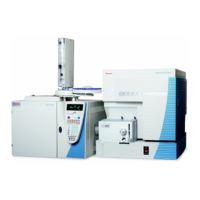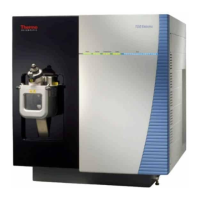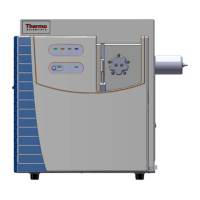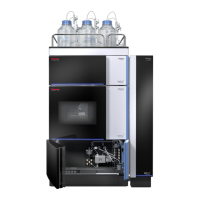1
Introduction
Scan Modes
Thermo Scientific TSQ Series Hardware Manual 7
Figure 2. Illustration of the parent scan mode
Experiments that employ the parent scan mode (parent experiments) can be used in structure
and fragmentation studies as well as in survey analyses of mixtures. In general, parent
experiments detect all compounds that decompose to a common fragment. The experiments
are useful for the rapid detection of a series of structural homologs (for example, substituted
aromatics, phthalates, steroids, or fatty acids) that have a common fragment ion (for example,
m/z 149 for the phthalates).
Neutral Loss Scan Modes
In the neutral loss scan mode, the two mass analyzers (Q1 and Q3) are linked together so that
they are scanned at the same rate over mass ranges of the same width. The respective mass
ranges, however, are offset by a selected mass so that the product mass analyzer scans a selected
number of mass units lower than the parent mass analyzer.
As a result, in the neutral loss scan mode, there are two stages of mass analysis. In the first
stage, the parent mass analyzer separates ions formed in the ion source by mass-to-charge
ratio. Then the ions are introduced sequentially into the collision cell.
In the second stage of analysis, ions admitted to the collision cell can fragment further by
metastable ion decomposition or by CID to produce product ions. The product mass analyzer
then separates these product ions by their mass-to-charge ratio. Figure 3 illustrates the neutral
loss scan mode. Examples of compounds with a common neutral loss fragment appear in
Figure 4.
For an ion to be detected, between the time the ion leaves Q1 and enters Q3, it must lose a
neutral moiety whose mass (the neutral loss mass) is equal to the difference in the mass ranges
being scanned by the two mass analyzers. Thus, a neutral loss mass spectrum is a spectrum
that shows all the parent ions that lose a neutral species of a selected mass.
Q2
RF Only + Ar
Q1 Scanning Q3 Set
Q1 m/z

